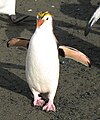User:Snowmanradio/Sandbox Pen
Appearance
Photographs of the adults of living species of Penguins:
Two species:[1]
| Aptenodytes | |||
|---|---|---|---|
| Common and binomial names[1] | Image | Description | Range |
| Emperor Penguins (Aptenodytes forsteri) |
 |
122 cm (48 in) tall weighing 22–37 kg (48.5–82 lb), the adult has deep black dorsal feathers, covering the head, chin, throat, back, dorsal part of the flippers, and tail. The underparts of the wings and belly are white, becoming pale yellow in the upper breast, ear patches are bright yellow. The upper mandible is black, and the lower mandible can be pink, orange or lilac. Males and females are similar in size and colouration. | Circumpolar distribution in the Antarctic between the 66° and 77° S. It almost always breeds on stable pack ice near the coast and up to 18 km (11 mi) offshore.[2] |
| King Penguins (Aptenodytes patagonicus) |
 |
90 cm (3 ft) tall and weighing 11 to 16 kg (24 to 35 lb), The upperparts are steel blue-grey, darkening to black on the head, the belly is white fading to orange on the upper breast with bright orange ear patches. The black bill is long and slender, and curved downwards. The lower mandible bears a striking pink or orange-coloured mandibular plate | Breeds on the subantarctic islands between 45° and 55° S at the northern reaches of Antarctica, as well as Tierra del Fuego, the Falkland Islands, and other temperate islands of the region. |
- Pygoscelis, Brush-tailed penguins (3 species)
-
Chinstrap Penguin
Pygoscelis antarctica -
Gentoo Penguin
Pygoscelis papua -
Adelie Penguin
Pygoscelis adeliae
- Eudyptula, Little penguins (1 or 2 species)
-
Little Penguin or Fairy Penguin
Eudyptula minor -
White-flippered Penguin
Eudyptula albosignata
- Spheniscus, Banded penguins (4 species)
-
African Penguin or Jackass Penguin
Spheniscus demersus -
Galapagos Penguins
Spheniscus mendiculus -
Humboldt Penguin
Spheniscus humboldti -
Magellanic Penguin
Spheniscus magellanicus
- Megadyptes, Yellow-eyed Penguin
-
Yellow-eyed Penguin
Megadyptes antipodes
- Eudyptes, Crested penguins (6–8 living species)
-
Royal Penguin
Eudyptes schlegeli -
Southern Rockhopper Penguin
Eudyptes chrysocome -
Fiordland Penguin
Eudyptes pachyrhynchus -
Snares Penguin
Eudyptes robustus -
Macaroni Penguin
Eudyptes chrysolophus
General gallery
[edit]-
Macaroni penguin at South Georgia Island
-
Chinstrap Penguin feeding a chick in Antarctica
-
Adélie chicks in Antarctica
- ^ a b Cite error: The named reference
zoonomenwas invoked but never defined (see the help page). - ^ University of Michigan Museum of Zoology. "Aptenodytes forsteri". Retrieved 2008-01-01.



















